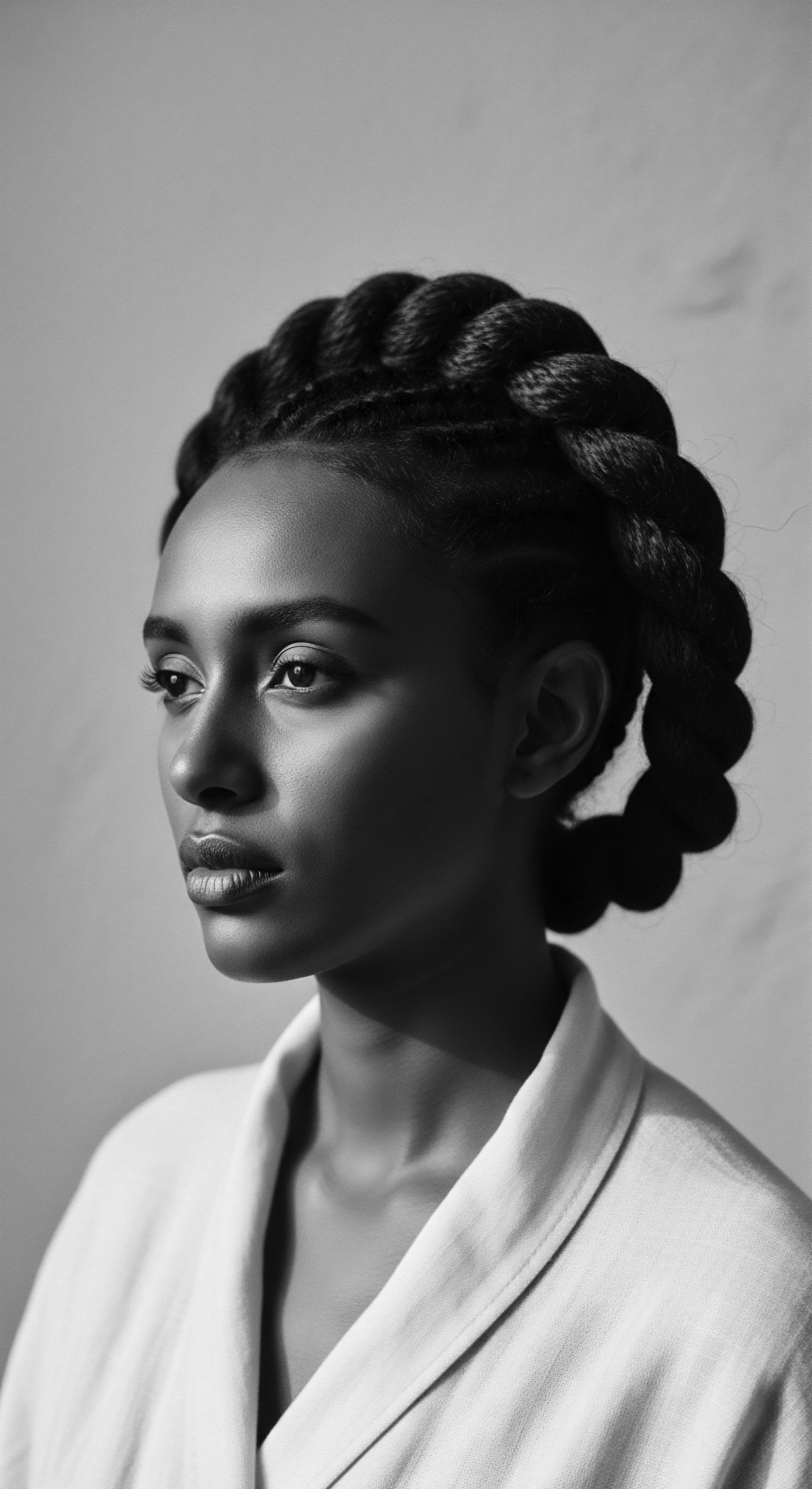
Fundamentals
The study of Kemetic Hairstyles opens a doorway into the rich tapestry of ancient Nile Valley civilizations, particularly that of Kemet, or ancient Egypt. At its core, the term describes the collective practices, styles, and meanings associated with hair and hair care during this millennia-long period. This involves an exploration of natural hair textures, wig construction, grooming rituals, and the profound social, spiritual, and ceremonial significance attributed to hair within Kemetic society. Understanding Kemetic Hairstyles is to comprehend how a people’s relationship with their appearance reflected deeper truths about their world, connecting the physical self to the cosmic order and communal identity.
These ancient expressions of self, deeply rooted in the continent’s soil, lay a foundational understanding for the enduring legacy of textured hair care and aesthetic traditions that persist through generations within Black and mixed-race communities. The meticulous attention paid to coiffure in Kemet was not merely an aesthetic preference; it was a deeply ingrained cultural practice that spoke volumes about an individual’s station, their spiritual beliefs, and their place within the societal structure.
The fundamental significance of hair in ancient Kemet was that it embodied vitality and the very essence of life. As a natural growth that continued even after death, hair held a deep symbolic weight, often seen as representing personal power and energy. The concept of hair as a profound marker extended across various ancient cultures, yet in Kemet, its importance was woven into daily life and sacred rites.

Hair as a Societal Beacon
Within Kemetic society, hair length served as a visual indicator of social standing. Affluent individuals could maintain longer styles, a practice made possible by the luxury of having servants to tend to and braid their hair. For laborers, long hair under the intense Egyptian sun was impractical, quickly becoming soiled and unkempt, thus making shorter styles or shaved heads more common. This social stratification is a powerful testament to how deeply ingrained hair practices were within the Kemetic framework.
Hair served as a visual language within ancient Kemet, communicating social hierarchy, age, and even spiritual devotion through its length, style, and adornment.
Ancient Kemetic society was structured, and hair served as a clear marker of one’s place. Both men and women of the elite classes frequently wore elaborate wigs, crafted from human hair, wool, or plant fibers. These wigs, often intricately braided and adorned with gold, beads, or other valuable materials, symbolized wealth, religious dedication, and a connection to divine entities.
The more opulent and decorated the hairstyle, the higher one’s social standing. Pharaohs, for instance, often adopted stylized wigs or headdresses that signified their royal status and divine authority.

Early Hair Care Practices
From the earliest periods, Kemetic people developed sophisticated methods for hair care. Archaeological discoveries have brought forth an array of ancient hair accessories, including combs, hairpins, and mirrors, found in burial sites, underscoring the importance placed on hair and hairstyling in both life and the afterlife. Early combs, particularly from Predynastic Kemet, were often shaped as “piks” and served as status symbols, sometimes adorned with animal motifs, suggesting a religious or power connection. The recognition of these combs’ unique design for African hair types, with wider gaps between teeth, is a compelling detail, suggesting an intuitive understanding of textured hair’s specific needs even millennia ago.
- Combs ❉ The earliest combs in Predynastic Kemet were often in the form of a ‘pik’, serving both functional and symbolic purposes, sometimes adorned with animal motifs.
- Oils and Fats ❉ Natural oils such as castor and almond oils were used for hair nourishment, alongside animal fats and beeswax for styling and protection from the harsh desert climate.
- Henna ❉ Derived from the Lawsonia plant, henna was a vital component for coloring and strengthening hair, used to conceal gray strands and add a reddish tint.
Beyond aesthetics, Kemetic hair practices had a practical dimension. The arid climate necessitated protection from the sun, while hygiene was a constant concern. Many Egyptians, particularly priests, shaved their heads to prevent lice infestations, then often covered their scalps with wigs for comfort, protection, and aesthetic appeal. This blend of practicality with profound cultural meaning establishes the baseline for comprehending Kemetic Hairstyles.
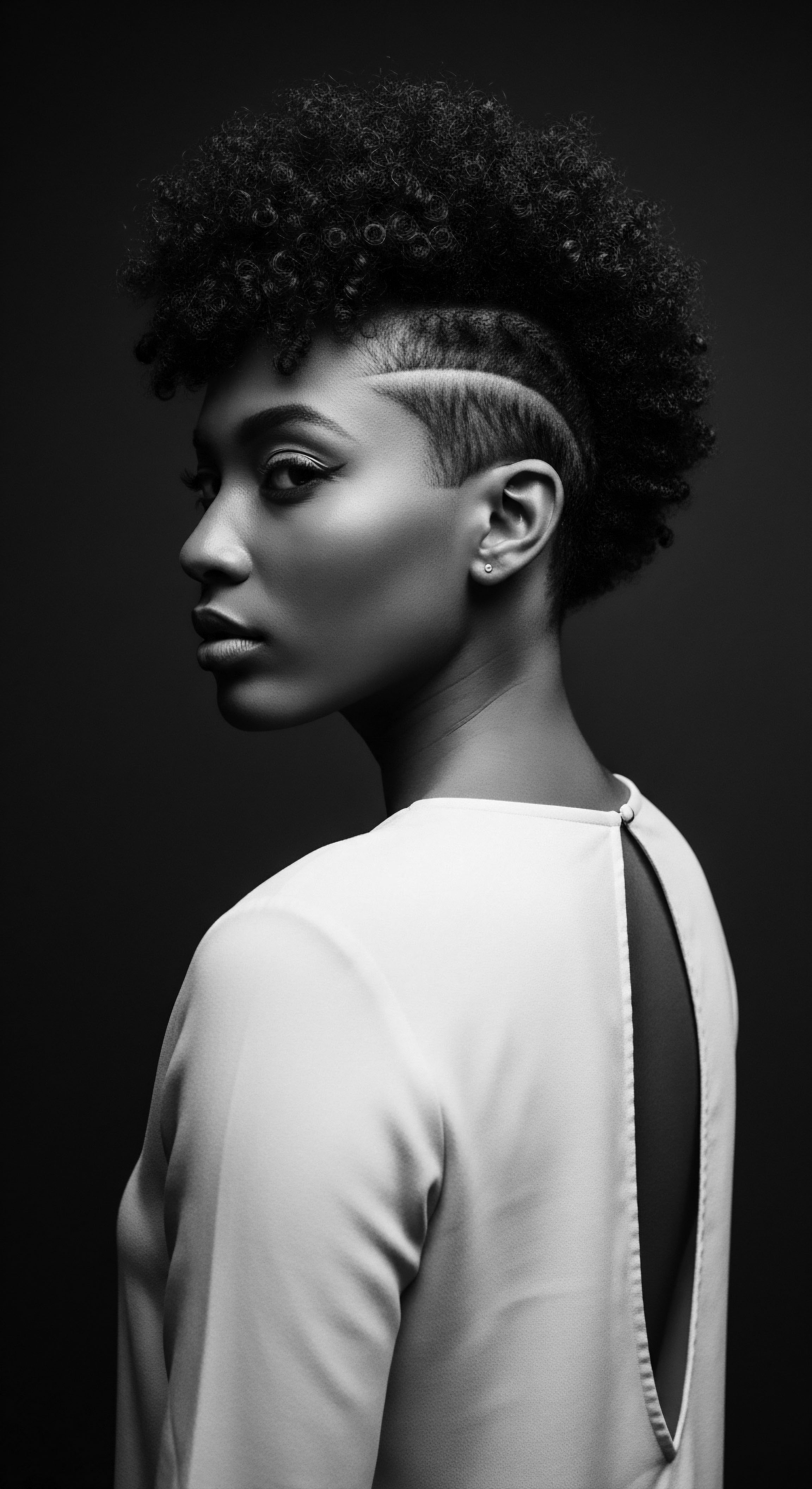
Intermediate
Delving deeper into Kemetic Hairstyles reveals a complex interplay of personal identity, societal expectations, and spiritual beliefs that transcend simple cosmetic considerations. This realm of understanding acknowledges the dynamic evolution of styles across different dynasties and the specialized skills involved in their creation and maintenance. Hair was not merely a physical attribute; it was a potent canvas for expressing selfhood and a connection to the ancestral wisdom that permeated Kemetic life.
The meaning of Kemetic Hairstyles is intricately tied to their function as a visual language, conveying age, marital status, and social position. For example, young girls wore a distinctive “sidelock of youth,” a single plait on one side of the head, a style they maintained until puberty. Married women and priestesses often wore more structured and elaborate styles, reflecting their roles and responsibilities within the community. These styles were far from arbitrary; they were imbued with meanings, sometimes connecting individuals to deities like Hathor, the goddess of fertility and beauty.
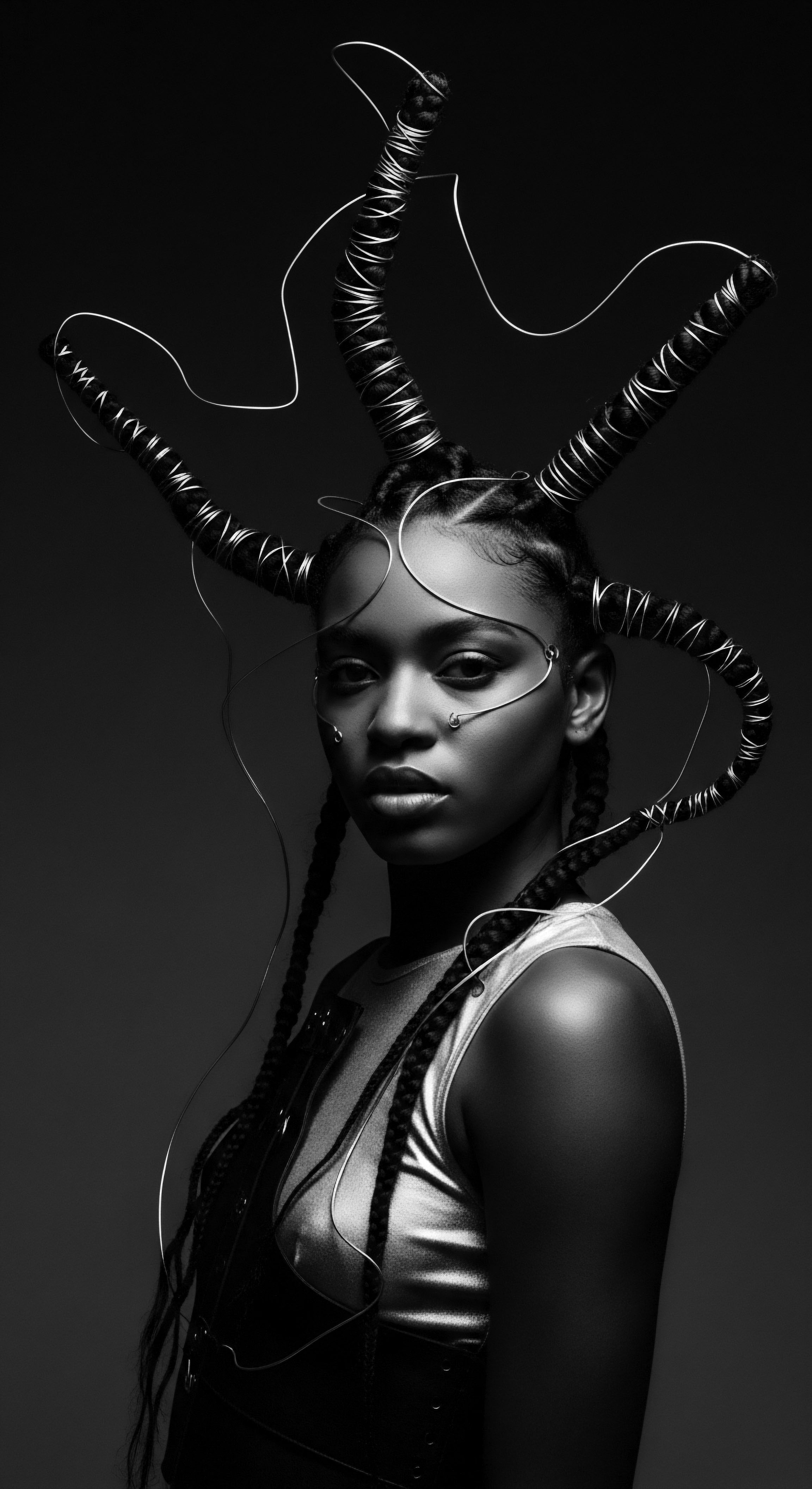
The Artistry of Kemetic Wigs and Hairpieces
Wigs played a particularly prominent role in Kemetic hairstyling, extending beyond mere fashion to encompass aspects of hygiene and social distinction. These elaborate hairpieces were meticulously crafted, often from human hair, and were considered valuable commodities in the ancient barter economy. Their expense meant they were largely confined to the elite, serving as a clear visual signal of wealth and social status. The sheer craftsmanship involved in creating a single wig is noteworthy, with some examples discovered containing hundreds of intricately plaited strands, all coated with resin and beeswax to maintain their form and luster.
Kemetic wig artistry exemplifies an ancient society’s profound dedication to personal presentation and the symbolic weight of coiffed hair.
Beyond full wigs, Kemetic people also incorporated hair extensions into their natural hair, particularly those who might not have afforded an entire wig. These extensions aimed to create a desired thick hair texture or to conceal thinning hair. This demonstrates a thoughtful approach to enhancing one’s appearance, recognizing and addressing diverse hair realities.
A fascinating example of this artistry and adaptation comes from the Amarna period, when the “Nubian wig” gained prominence. This style mimicked the short, curly hair traditionally worn by Nubian tribespeople, and historical accounts suggest figures like Queen Nefertiti adopted it after observing Nubians in the pharaoh’s army. This shows a cultural exchange and an appreciation for the aesthetics of textured hair, illustrating how Kemetic hairstyles were dynamic and influenced by diverse African forms.
The Nubian wig, distinct for its short, bushy appearance with rows of curls framing the face and exposing the nape of the neck, stands as a testament to the appreciation for naturally curly hair textures within Kemetic high society. This styling choice offers a glimpse into Nubian beauty standards and their influence across the broader Kemetic aesthetic landscape.
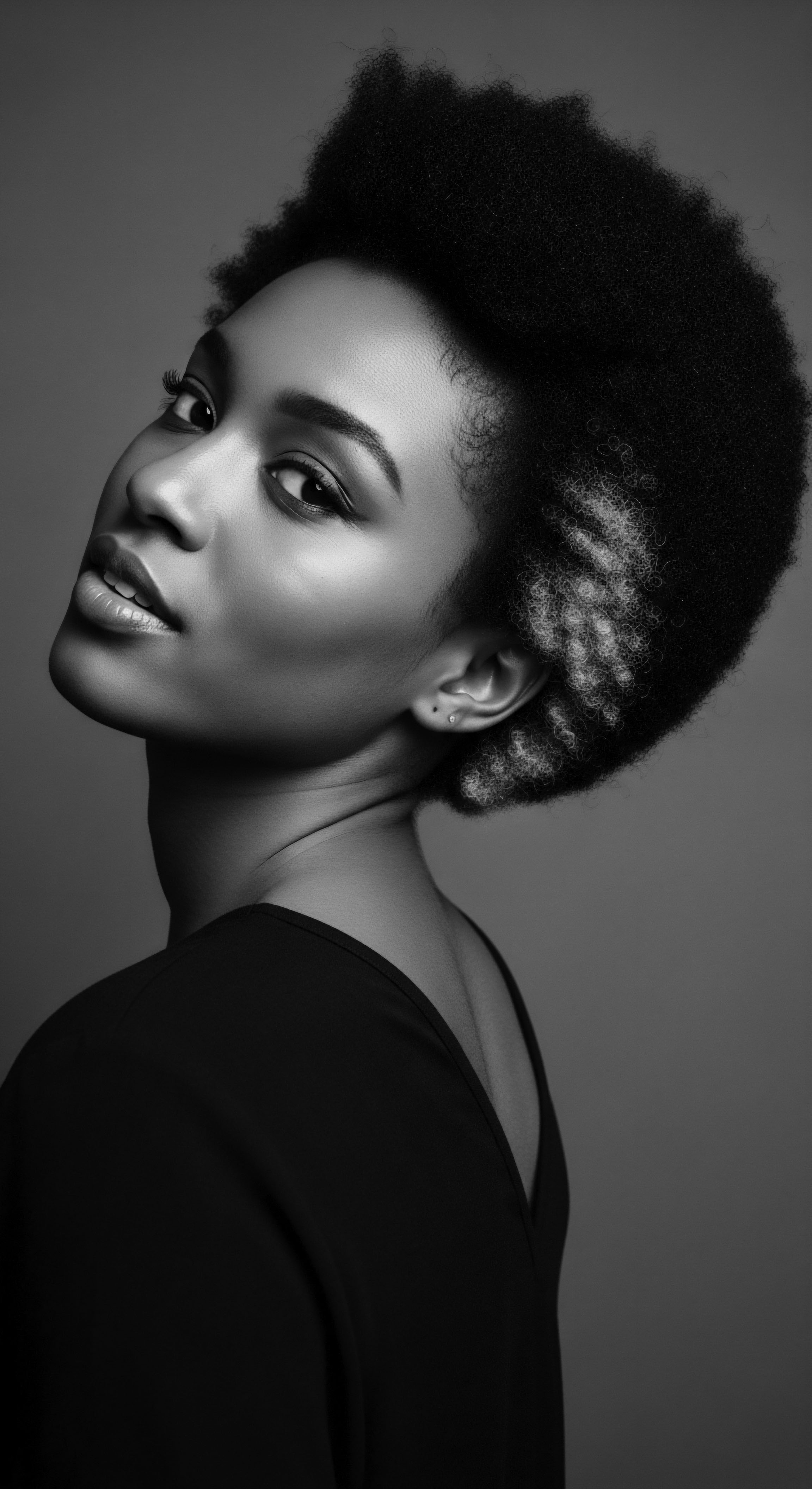
Rituals of Mourning and Spiritual Connections
Hair held a sacred place in Kemetic spiritual life, extending even to the realm of death and the afterlife. It symbolized vitality and the essence of life itself, retaining its growth even after the body’s passing. This belief imbued hair with deep spiritual meaning, and various rituals involving hair were part of funerary customs.
Mourners, both men and women, were frequently depicted with disheveled hair, even tearing at it and sprinkling ashes as an expression of sorrow. This visceral display highlights hair’s connection to intense human emotion and spiritual transitions.
Small braids or curls of human hair have been found carefully preserved in burial sites, stored in boxes, their precise purpose still debated—whether as extensions, hairpieces, or tokens of affection for the departed. Such discoveries indicate the lasting symbolic value placed on hair, even in the passage to the afterlife. Ancient funerary texts consistently mentioned hair, underscoring its role in both symbolic and ceremonial spheres connected to resurrection and rebirth.
The deliberate cutting of hair by “Drty” (or “kites”), women who performed mourning rituals in the roles of Isis and Nephthys, further illustrates this profound connection. Archaeological evidence and tomb scenes indicate that these mourning women appeared with short hair, signifying their ritualistic role in the funerary process. This deliberate alteration of hair was not merely an act of grief, but a ritual action deeply embedded in Kemetic beliefs surrounding death and rebirth.
The inclusion of meticulously preserved hair in Kemetic burial goods underscores its deep symbolic value, believed to facilitate the deceased’s journey and individuality in the afterlife.
The spiritual and protective power attributed to hair is evident in practices such as wearing amulets of fish, hair rings, or clasps for protection, particularly among the working classes. Even today, some black magic or spiritual practices continue to utilize hair as a powerful link to an individual, a legacy that some scholars argue can be traced back to these ancient beliefs. This deep historical and spiritual understanding of hair forms a crucial component of the Kemetic Hairstyles’ true essence.

Academic
An academic examination of Kemetic Hairstyles transcends surface-level observation, compelling a comprehensive exploration of its profound sociological, cultural, and scientific dimensions. The Kemetic approach to hair, particularly as it relates to textured hair heritage, serves as a rich archive, offering unparalleled insights into ancient societal structures, aesthetic ideals, and the enduring human connection to identity expressed through corporeal adornment. This nuanced understanding necessitates an interdisciplinary lens, drawing from archaeology, anthropology, and material science to construct a robust definition that resonates with contemporary discussions of Black and mixed-race hair experiences.
The meaning of Kemetic Hairstyles, at this academic juncture, is not merely a catalogue of ancient coiffures, but a sophisticated articulation of a civilization’s comprehensive understanding of human presentation as a multi-layered communication system. Hair in Kemet acted as a dynamic semiotic vehicle, conveying gender, age, social strata, and one’s sacred role in society. This goes beyond basic identification; it speaks to a deliberate, culturally constructed system where every strand held a specific weight of meaning and significance. The intricate designs and symbolism embedded within Kemetic hair practices have undeniably permeated and continued to influence contemporary African hair culture, particularly within the diaspora.

The Biology of Ancient Strands and the Science of Styling
Modern scientific inquiry offers compelling validation for the sophistication of Kemetic hair practices, particularly in relation to textured hair. A groundbreaking study by McCreesh, Gize, and David, published in the Journal of Archaeological Science in 2011, analyzed hair samples from 18 mummies, dating as far back as 3,500 years ago from various sites, including the Dakhleh Oasis. Their meticulous microscopy and gas chromatography-mass spectrometry (GC-MS) analysis revealed a startling discovery ❉ nine of these mummies possessed hair coated in a distinct, fat-like substance.
This substance was identified as containing biological long-chain fatty acids, including palmitic acid and stearic acid. The researchers interpreted this fatty coating as a styling product—akin to a modern hair gel or fixative—used by the ancient Egyptians to set and maintain hairstyles in both life and, remarkably, in preparation for the afterlife.
This scientific finding carries immense weight for the discourse on textured hair heritage. The use of a fat-based product suggests an understanding of hair’s needs, particularly for coily, kinky, or curly textures which often benefit from emollients to retain moisture, reduce frizz, and hold style without excessive dryness. Such a product would have been invaluable for maintaining the intricate braids, twists, and curls frequently depicted in Kemetic art and found on mummified remains.
This data underscores that Kemetic hair care was not rudimentary, but grounded in an empirical understanding of material properties and hair behavior. It serves as a direct, tangible link between ancient African ingenuity and current understandings of hair science, affirming the efficacy of traditional fatty-acid-rich conditioners and stylers used in Black hair care traditions globally.
Scientific analysis of ancient Kemetic mummy hair reveals advanced styling products, affirming an empirical understanding of hair care deeply relevant to textured hair.
Furthermore, the distinct differences noted in Kemetic combs compared to contemporary European artifacts—specifically the wider gaps between teeth in African combs—suggests a conscious design for the inherent properties of textured hair, which is prone to breakage if combed with fine-toothed implements. This seemingly minor detail speaks volumes about an ancestral knowledge of textured hair’s unique tensile strength and curl patterns. The historical presence of such tools, unearthed from graves, illustrates that hair care was not merely a superficial activity, but a practice for which specialized implements were developed with a deep understanding of the fiber itself.
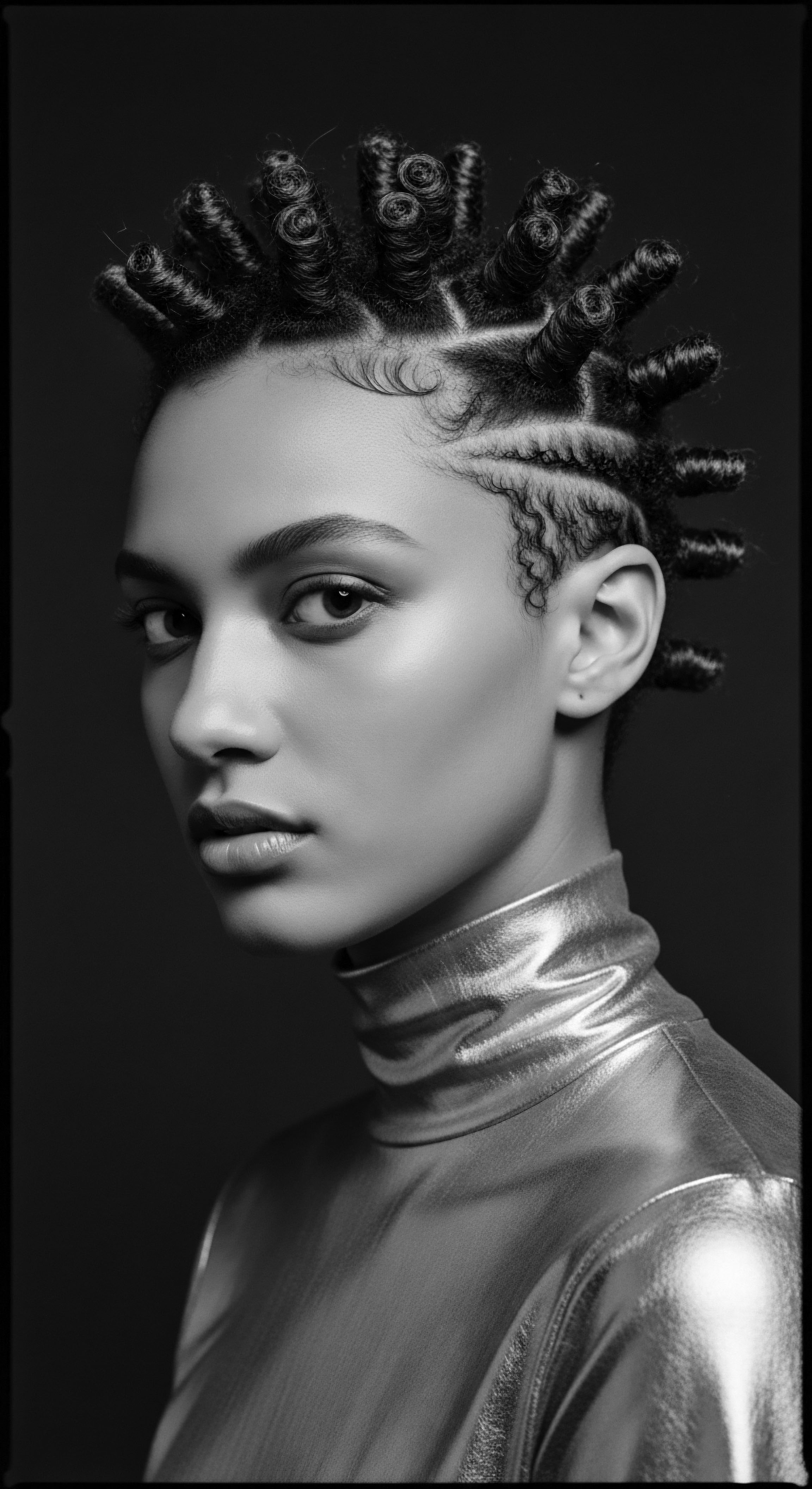
Hair as a Symbol of Resistance and Continuity in the Diaspora
The legacy of Kemetic Hairstyles extends far beyond the Nile Valley, serving as a powerful progenitor for the enduring cultural and sartorial expressions seen across the African diaspora. African hairstyles, broadly speaking, are more than aesthetic statements; they embody a profound cultural legacy, with each braid, twist, and adornment conveying narratives of social status, age, tribal affiliation, and spiritual convictions. The preservation of these practices despite centuries of displacement and oppression speaks to the resilience and deep cultural memory within Black communities globally.
The communal act of braiding and styling hair, a practice dating back to ancient African societies, was a means of socializing and bonding, a tradition that continues to hold significance for many people of color today. This collective engagement in hair care, often passed down through generations, strengthens familial and communal ties, forming a continuous thread of shared heritage. The act of braiding in enslaved communities, for example, allowed individuals separated from their families and tribes to recreate a sense of kinship and cultural continuity, a practice essential for survival and collective fortitude.
The enduring tradition of communal hair styling in the African diaspora directly mirrors ancient Kemetic practices, preserving a profound sense of shared heritage and collective resilience.
The contemporary significance of Kemetic and broader African hairstyles is further amplified through their role as symbols of resistance against Eurocentric beauty norms. The Afro hairstyle, which gained prominence during the Civil Rights Movement, emerged as a powerful statement against dominant beauty standards, becoming an emblem of Black pride and unity. Icons such as Angela Davis and the Black Panther Party popularized the Afro, cementing its status as a symbol of self-determination, empowerment, and a direct connection to African roots. This deliberate re-assertion of natural hair, echoing the varied textures celebrated in ancient Kemet, showcases a continuous lineage of identity affirmation.
| Kemetic Practice/Feature Wigs and Hair Extensions ❉ Used for hygiene, status, and diverse styling (often curly/plaited). |
| Contemporary Diasporic Parallel/Significance Wig and Extension Culture ❉ Pervasive in Black hair practices for protective styling, versatility, and aesthetic expression, allowing for diverse looks without manipulating natural hair. |
| Kemetic Practice/Feature Fat-Based Styling Products ❉ Identified scientifically in mummy hair, indicating advanced conditioning and styling agents. |
| Contemporary Diasporic Parallel/Significance Natural Oils and Butters ❉ Central to textured hair care (e.g. shea butter, coconut oil, castor oil), providing moisture, hold, and promoting hair health, mirroring ancient emollient use. |
| Kemetic Practice/Feature Wide-Toothed Combs/Piks ❉ Evidence of combs designed with wider gaps, suggesting an understanding of textured hair’s fragility. |
| Contemporary Diasporic Parallel/Significance Afro Picks and Wide-Tooth Combs ❉ Essential tools for detangling and styling textured hair today, preventing breakage and maintaining curl integrity. |
| Kemetic Practice/Feature Braids and Plaits ❉ Common styles for men and women, with symbolic meanings attached to patterns and length. |
| Contemporary Diasporic Parallel/Significance Braiding Traditions ❉ Cornrows, box braids, dreadlocks (often linked to ancient Egyptian styles), serving as protective styles, cultural markers, and expressions of identity across the diaspora. |
| Kemetic Practice/Feature Hair as a Symbol of Status/Identity ❉ Length, style, and adornment conveyed social standing, age, and religious adherence. |
| Contemporary Diasporic Parallel/Significance Hair as Identity and Resistance ❉ Natural hair movement, locs, and Afros as statements of Black pride, cultural heritage, and defiance against oppressive beauty standards. |
| Kemetic Practice/Feature The enduring wisdom of Kemetic hair practices continues to inform and inspire contemporary Black and mixed-race hair traditions, demonstrating a profound ancestral link. |

Interconnected Incidences ❉ Race, Identity, and the Kemetic Hair Legacy
The dialogue surrounding Kemetic Hairstyles is inextricably linked to ongoing conversations about race, identity, and authenticity, particularly within the context of contemporary Egypt and the wider African diaspora. Scholars observe a lack of dedicated scholarship on race in Egypt outside of migration contexts, yet the lived experience demonstrates its deep presence. Assistant Professor Ramy Aly’s research on contemporary Egyptian hair culture offers illuminating insights into how race functions socially, noting that while elites historically looked northward for identity, younger generations are increasingly comfortable identifying as African. This shift creates space for acknowledging the profound historical connection between Kemetic hair traditions and textured hair heritage across the continent and beyond.
The historical emphasis on “whitening” in Egypt over the last two centuries, associating European features with beauty and respectability, has cast a long shadow on perceptions of natural hair textures. However, the rising acceptance of locs and curly hair in contemporary Egypt, as observed by Aly, signals a redefinition of relationships with Africanness and a reclamation of indigenous beauty standards. This mirrors the global natural hair movement within the African diaspora, where individuals reclaim traditional styles as acts of self-affirmation and connection to their ancestral past.
The debate surrounding cultural appropriation, especially concerning styles with deep roots in Kemetic and broader African heritage, becomes pertinent here. When elements of traditional African culture are adopted by those outside the cultural group in ways that disrespect or oversimplify the original meaning, important questions arise about authenticity and ethical representation. Understanding the deep historical and spiritual meaning of Kemetic Hairstyles is therefore vital for ensuring these practices are honored and respected as part of a living, breathing heritage, rather than merely superficial trends.
The visual evidence from ancient Kemet, depicting a diverse range of hair textures—from tightly coiled to wavy—often styled in braids, twists, and locs, offers a powerful counter-narrative to Eurocentric aesthetic impositions. Queen Tiye’s statue, for example, is recognized for its depiction of an Afro hairstyle, standing as a historical testament to the acceptance and regal presentation of natural texture in ancient royal contexts. This historical validation provides a powerful foundation for understanding the significance of natural hair within Black identity today.
- Royal Wigs and Natural Textures ❉ Elite Kemetic individuals, including queens and nobles, wore elaborate wigs, which often incorporated plaits, twists, and curls, suggesting the aesthetic appeal of textured hair types was appreciated and emulated.
- Hair Dyeing Practices ❉ Ancient Egyptians used henna to color hair, particularly to cover grayness, a practice that continues widely today in hair care traditions.
- Hair as Power Symbol ❉ Pharaohs often depicted themselves grasping enemies by the hair, a powerful symbol of dominance and submission, emphasizing hair’s connection to power and control within society.
Kemetic Hairstyles, therefore, stands as a testament to the sophistication of ancient African societies in their approach to appearance, health, and cultural expression. The profound insights gleaned from archaeological findings, scientific analysis of mummified remains, and anthropological studies demonstrate that the care and styling of hair were integral to identity formation, social stratification, and spiritual belief systems, creating a timeless legacy that continues to resonate with textured hair heritage globally.

Reflection on the Heritage of Kemetic Hairstyles
To consider Kemetic Hairstyles is to stand at the confluence of ancient wisdom and modern resonance, observing how strands of the past continue to weave through the present. This understanding invites us into a meditative space where hair transcends its biological composition to become a living chronicle of identity, resilience, and profound heritage. The meticulous practices of ancient Kemet, from the sophisticated use of fatty acids as styling agents to the deliberate design of wide-toothed combs, whisper tales of an innate understanding of textured hair—a deep, embodied knowledge passed down through generations.
The enduring legacy of Kemetic Hairstyles serves as a powerful validation for the continuum of Black and mixed-race hair experiences. It reminds us that the beauty, versatility, and expressive power of textured hair are not new discoveries, but rather echoes from a venerable source. Each braid, each twist, each thoughtful application of nourishing oils today can be seen as a tender thread connecting us to ancestral hands that practiced similar rituals thousands of years ago. This connection provides not only a sense of pride but also a grounding in practices that were once elemental to health, status, and spiritual connection.
The journey of Kemetic Hairstyles, from its elemental biology and ancient practices, through living traditions of care and community, to its role in voicing identity and shaping futures, reveals a magnificent, unbound helix of history. The meticulous care of hair in Kemet, whether natural or adorned with elaborate wigs, was a reflection of the individual’s spiritual standing and their place in the collective consciousness. This perspective shifts our understanding of hair from a mere cosmetic concern to a sacred extension of self, a profound vessel of ancestral memory. It invites us to honor the wisdom embedded in every curl and coil, recognizing our hair as a direct link to the ingenuity and spirit of those who walked the Nile Valley path before us.

References
- Byrd, A. D. & Tharps, L. L. (2014). Hair story ❉ Untangling the roots of Black hair in America. St. Martin’s Griffin.
- McCreesh, N. C. Gize, A. P. & David, A. R. (2011). Ancient Egyptian Hair Gel ❉ New Insight into Ancient Egyptian Mummification Procedures through Chemical Analysis. Journal of Archaeological Science, 38(12), 3432-3434.
- Valdesogo, M. R. (2014). Hair and death in ancient Egypt ❉ The mourning rite in the times of the Pharaohs. Archaeopress Publishing Ltd.
- Riggs, C. (2017). Unwrapping Ancient Egypt. Bloomsbury Academic.
- Stevens, A. (2006). Private Religion at Amarna ❉ The Material Evidence. Archaeopress.
- Fletcher, J. (2015). The Story of Egypt. Hodder & Stoughton.
- Robins, G. (1993). Women in Ancient Egypt. British Museum Press.
- Petrie, W. M. F. (1927). Objects of Daily Use. British School of Archaeology in Egypt.
